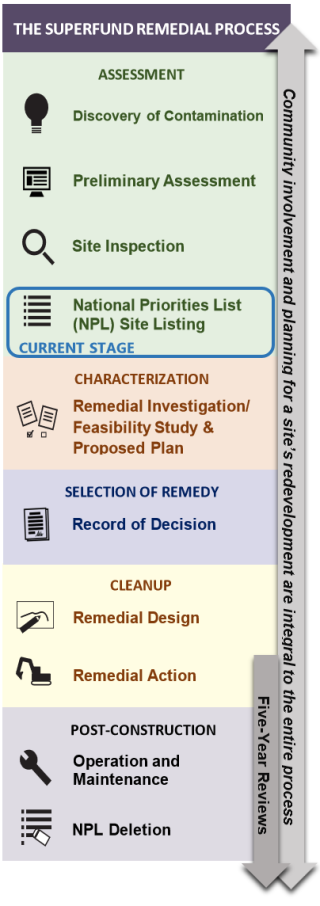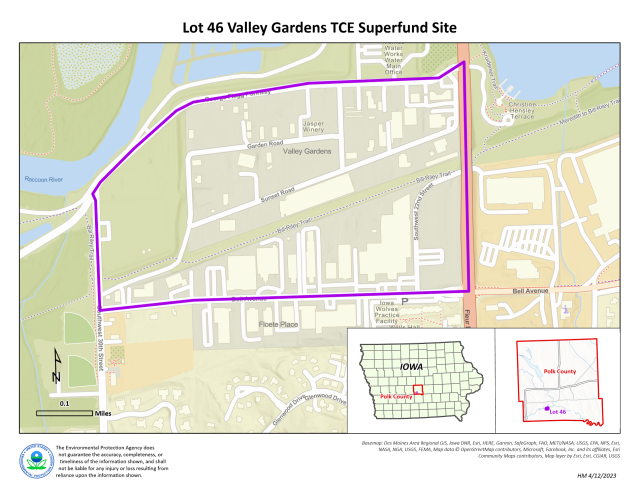Lot 46 Valley Gardens TCE Superfund Site, Des Moines, Iowa – Fact Sheet, June 2023
Site Update
About the Site
boundary. (U.S. EPA image)
The Lot 46 Valley Gardens Trichloroethylene (TCE) Superfund Site is a TCE-contaminated groundwater plume in Des Moines, Iowa. Investigations led by the Iowa Department of Natural Resources (IDNR) began in 2004, and IDNR referred the site to EPA in 2020 for federal assistance. After monitoring the plume and observing its migration, EPA will propose the site to the National Priorities List in late 2023. Listing the site on the NPL will support long-term cleanup efforts, impede further plume migration, and prevent exposure to site contamination.
The site groundwater contamination plume extends northwest toward the city of Des Moines Water Works (DMWW) Fleur Drive Treatment Plant infiltration gallery, a series of underground water collection pipes adjacent to the Raccoon River. The infiltration gallery draws its water supply from a combination of both local groundwater and the Raccoon River. EPA is working with DMWW to sample water from along the infiltration gallery and the site groundwater monitoring well network to ensure that source water is of the highest quality.
Currently, TCE and its degradation products have not been detected in the infiltration gallery at concentrations exceeding safe drinking water standards. Additionally, TCE and its degradation products have not been detected at concentrations exceeding levels of ecological concern in site monitoring wells near the Raccoon River. Monitoring and investigation will continue. EPA has the authority to perform an immediate or short-term action at any time should data indicate an increased risk to the drinking water supply.
TCE and its degradation products in soil and/or groundwater may emit vapors. Based on current groundwater data, limited soil gas data, and the distribution of TCE and its degradation products in these samples, EPA has not identified a significant risk of exposure to such vapors at this time. However, investigation of vapor sources and pathways is ongoing.
For more information, visit EPA's response page.
Can I drink my water?

Yes. DMWW provides water that meets all state and federal drinking water health standards. To learn more, see the DMWW TCE Fact Sheet.
What is Superfund?
Superfund refers to hazardous waste sites and EPA’s cleanup process. It is the common name for the Comprehensive Environmental Response, Compensation, and Liability Act (CERCLA). This federal law authorizes EPA to clean up contaminated sites.
What is Trichloroethylene (TCE)?
Trichloroethylene (TCE, also trichloroethene) is a contaminant of concern (COC) at the site. COCs are chemicals that need to be addressed by a cleanup action because they are a potential threat to human health or the environment. TCE is a volatile organic compound, or VOC. This kind of organic chemical compound evaporates under normal indoor temperatures and pressure. TCE is part of some industrial and commercial processes. It is one of the most common contaminants at Superfund sites. The Centers for Disease Control and Prevention’s Agency for Toxic Substances and Disease Registry (ATSDR) has a TCE summary on the ToxFAQs website.
EPA Contact Information
Lauren Murphy
Remedial Project Manager
EPA Region 7 (SEMD/REMB/SRWS)
11201 Renner Boulevard
Lenexa, KS 66219
Phone: 913-551-7622
Toll-free: 1-800-223-0425
Email: murphy.lauren@epa.gov
Elizabeth Kramer
Community Involvement Coordinator
U.S. EPA Region 7
11201 Renner Boulevard
Lenexa, KS 66219
Phone: 913-551-7186
Toll-free: 1-800-223-0425
Email: kramer.elizabeth@epa.gov

